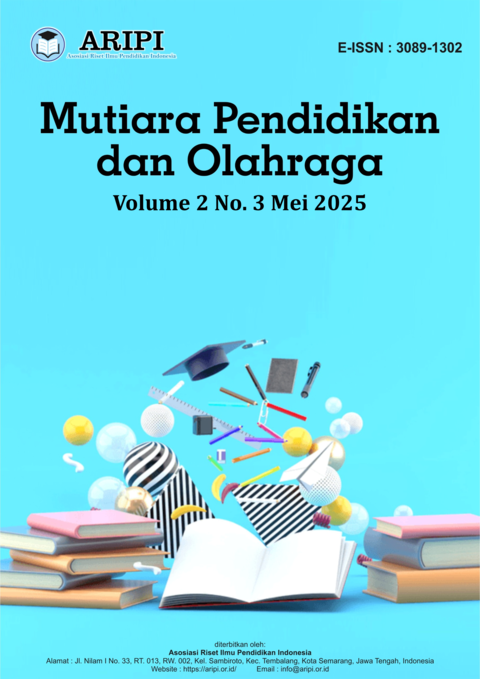Analisis Keberhasilan Lebron James Menjadi MVP di Olimpiade Paris 2024
DOI:
https://doi.org/10.61132/mupeno.v2i3.235Keywords:
Analysis, Basketball, MVPAbstract
Basketball is a dynamic team sport that emphasizes hand coordination, requiring players to score by shooting the ball into the opponent’s hoop. The game involves five players per team and demands mastery of several fundamental technical skills, including throwing and catching, dribbling, shooting, pivoting, and lay-up techniques. One of the highest individual achievements in basketball is being named the Most Valuable Player (MVP), a title awarded to athletes who demonstrate exceptional performance during a game or tournament. This study aims to analyze the determining factors behind an athlete achieving MVP status, specifically focusing on LeBron James from the United States basketball team during the 2024 Paris Olympics final match against France. The research employs a descriptive method with data collection through document analysis, particularly using official match statistics. The assessment includes both physical performance metrics—such as points, rebounds, assists, blocks, steals, turnovers, and fouls—and psychological aspects, such as mental toughness during competition. Statistical data from the match showed that LeBron James recorded 14 points, 6 rebounds, 1 block, 10 assists, 2 steals, 5 turnovers, and 3 fouls. His shooting efficiency was also high, with a 60% field goal percentage (6/10), 62.5% on two-point shots (5/8), 50% on three-point shots (1/2), and 100% on free throws (1/1). The findings indicate that high contributions in both offensive and defensive aspects significantly influence the MVP designation. This study concludes that MVP recognition is strongly supported by measurable statistical performance and recommends that coaches integrate performance analysis technology to maximize athlete potential based on individual needs.
References
Agus, R. M. (2021). Analysis of physical activity children aged 7–8 years in the time of adaptation to new habits. The 1st International Conference on Language Linguistic Literature and Education (ICLLLE).
Ahmadi, N. (2007). Permainan bola basket. Surakarta: Era Intermedia.
Bisagno, E., Morra, S., Basciano, M., Rosina, C., & Vitali, F. (2019). Assessing individual performance in team sports: A new method developed in youth volleyball. Journal of Functional Morphology and Kinesiology, 4(3), 53. https://doi.org/10.3390/jfmk4030053
Chunmei, C. (2021). Research progress on selection methods of volleyball players. Journal of Advances in Sports and Physical Education, 4(8), 172–181.
Ericsson, K. A. (1999). The world’s foremost expert on expert. Florida State University. https://psychology.fsu.edu/article/k-anders-ericsson-1947-2020-worlds-foremost-xpert-expert-performance
Harwood, C. (2002). Assessing achievement goals in sport: Caveats for consultants and a case for contextualization. Journal of Applied Sport Psychology, 14(2), 106–119. https://doi.org/10.1080/10413200252907766
Hidayatullah, F. (2012). Analisis indikator performa yang mempengaruhi kemenangan dengan persentase tembakan rendah dalam National Basketball League Indonesia [Skripsi, Universitas Negeri Surabaya].
Ibanez, S. J., García, J., Feu, S., Lorenzo, A., & Sampaio, J. (2009). Effects of consecutive basketball games on the game-related statistics that discriminate winner and losing teams. Journal of Sports Science & Medicine, 8(3), 458–462.
Koehn, S. (2013). Effects of confidence and anxiety on flow state in competition. European Journal of Sport Science, 13(5), 543–550. https://doi.org/10.1080/17461391.2012.744845
Kosasih, D. (2008). Fundamental basketball first step to win. Semarang: Karangturi Media.
Kurniawan, R. D., & Hariyanto, A. (2018). Efektivitas permainan peserta Indonesian Basketball League (IBL) 2017/2018 pada pertandingan semifinal dan final (berdasarkan statistik pertandingan). Jurnal Prestasi Olahraga, 1(4), 1–10.
McDonnell, K. L., Hume, A. P., & Nolte, V. (2013). Place time consistency and stroke rates required for success in K1 200-m sprint kayaking elite competition. International Journal of Performance Analysis in Sport, 13(1), 38–50.
Muhajir. (2016). Pendidikan jasmani, olahraga dan kesehatan untuk SMA/MA kelas X. Bandung: Erlangga.
Oliver, D. (2004). Basketball on paper: Rules and tools for performance analysis. Washington, D.C.: Potomac Books, Inc.
Oliver, J. (2007). Dasar-dasar bola basket. Bandung: PT Intan Sejati.
Sarumpaet, A., Djazet, Z., & Sadikun, I. (1992). Permainan bola besar. Jakarta: Depdikbud, Dirjendikti, Proyek Pembinaan Tenaga Kependidikan.
Schinke, R. J., Stambulova, N. B., Si, G., & Moore, Z. (2018). International society of sport psychology position stand: Athletes’ mental health, performance, and development. International Journal of Sport and Exercise Psychology, 16(6), 622–639. https://doi.org/10.1080/1612197X.2017.1295557
Soendari, T. (2012). Metode penelitian deskriptif. Bandung: UPI.
Stuss, M., & Herdan, A. (n.d.). [Referensi tidak lengkap, harap lengkapi judul dan sumber].
Sudibyo, S. (1993). Psikologi kepelatihan. Jakarta: CV Jaya Sakti.
Sumiyarsono, D. (2002). Keterampilan bola basket. Yogyakarta: Fakultas Ilmu Keolahragaan (FIK), Universitas Negeri Yogyakarta.
Tiffany, A., & Azmi, F. (2020). Diplomasi publik Indonesia melalui penyelenggaraan Asian Games 2018. Padjadjaran Journal of International Relations, 1(3), 202–216.
Tridhonanto, A. (2010). Meraih sukses dengan kecerdasan emosional. Jakarta: Elex Media Komputindo.
Trninic, S., Dizdar, D., & Lukšić, E. (2002). Differences between winning and defeated top quality basketball teams in final tournaments of European club championship. Collegium Antropologicum, 26(2), 521–531.
Undang-Undang Republik Indonesia Nomor 20 Tahun 2003 tentang Sistem Pendidikan Nasional.
Weinberg, R. S., & Gould, D. (2023). Foundations of sport and exercise psychology (8th ed.). Champaign, IL: Human Kinetics.
Wissel, H. (2000). Basketball steps to success. Champaign, IL: Human Kinetics.
Wissel, H. (2012). Basketball steps to success (3rd ed.). United States of America: Human Kinetics.
Downloads
Published
How to Cite
Issue
Section
License
Copyright (c) 2025 Mutiara Pendidikan dan Olahraga

This work is licensed under a Creative Commons Attribution-ShareAlike 4.0 International License.





